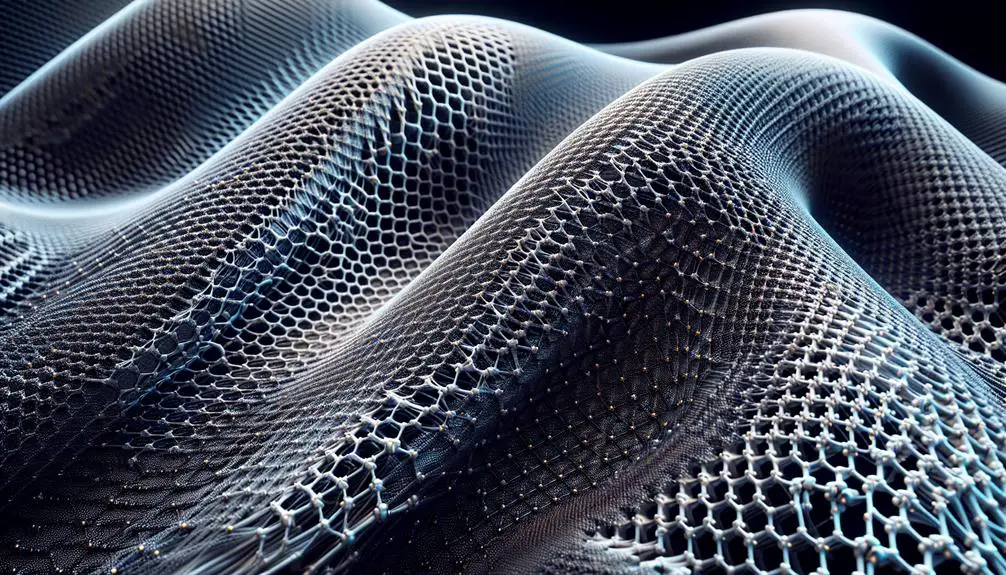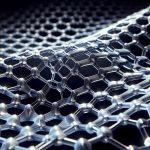Imagine a jacket that keeps you warm in winter and cool in summer, like the one created by the company Vollebak using graphene-enhanced fabric. You might be wondering how a single material can promise such versatility and durability. Graphene, a single layer of carbon atoms arranged in a hexagonal lattice, offers exceptional strength, flexibility, and electrical conductivity. These unique properties are revolutionizing the textile industry, making fabrics more functional and resilient than ever before. Curious about how this innovation could change your daily wear and health monitoring? There's much more to uncover about this groundbreaking technology.
Table of Contents
Key Takeaways
- Graphene-enhanced fabrics offer unmatched strength, flexibility, and electrical conductivity for versatile textile applications.
- They enhance fabric durability, ensuring resistance to wear, tear, and long-lasting performance.
- These fabrics provide advanced thermal regulation, ensuring optimal comfort and climate control.
- Graphene integration in textiles supports smart clothing with real-time health monitoring and interactive features.
- They contribute to sustainable, eco-friendly textile production with antibacterial and UV protection benefits.
What Is Graphene?
Graphene is a single layer of carbon atoms arranged in a two-dimensional honeycomb lattice. This unique structure gives graphene remarkable properties that are the focus of extensive research worldwide.
As you explore graphene research, you'll uncover its potential to revolutionize various fields, including textiles. Its unparalleled strength, flexibility, and conductivity make it a game-changer for numerous applications.
In the domain of graphene applications, the material's versatility is truly astounding. From enhancing electronic devices to improving energy storage systems, graphene's uses are only limited by your creativity.
In textiles, integrating graphene can lead to fabrics that are more durable, conductive, and even capable of monitoring health metrics.
To master the intricacies of graphene, you need to understand the breadth of ongoing research. Scientists are continually exploring new ways to produce, manipulate, and apply graphene to reveal its full potential. Keeping abreast of the latest developments will give you an edge in leveraging graphene for innovative solutions.
Properties of Graphene
With its unparalleled strength, flexibility, and electrical conductivity, this material's properties make it a cornerstone of cutting-edge research and innovation. You're delving into a world where graphene's unique characteristics are revolutionizing numerous fields.
Imagine a fabric that not only bends and stretches without breaking but also conducts electricity seamlessly. That's the power of graphene.
Graphene's strength is off the charts—200 times stronger than steel, yet incredibly lightweight. This makes it invaluable for flexible electronics, where durability and pliability are paramount.
Picture wearable sensors that monitor your health in real-time without compromising comfort. That's where graphene steps in.
In the domain of biomedical applications, graphene's biocompatibility and conductivity are game-changers. It can be used to create bioelectronic devices that interact seamlessly with biological tissues, enhancing medical diagnostics and treatment.
Its antibacterial properties also make it ideal for medical textiles, reducing infection risks.
Conductivity is another cornerstone. Graphene conducts electricity better than copper, opening avenues for advanced conductive fabrics. These could power everything from smart clothing to next-gen communication devices.
Fabrication Techniques
To harness graphene's remarkable properties in textiles, you need to master specialized fabrication techniques. Nano scale production and innovative methods are vital to integrating graphene seamlessly into fabrics. One popular approach is chemical vapor deposition (CVD), where you grow graphene layers directly onto the textile fibers. This method guarantees a uniform coating and preserves the material's flexibility.
For eco-friendly practices, focus on sustainable sourcing of raw materials and minimizing waste during production. Techniques like roll-to-roll processing can be more efficient and reduce environmental impact. Additionally, consider using water-based, non-toxic solvents to exfoliate graphene from graphite.
Here's a breakdown of essential techniques:
- Chemical Vapor Deposition (CVD): Grow graphene layers on textile fibers for uniform coating.
- Roll-to-Roll Processing: Efficiently integrate graphene in continuous fabric production.
- Water-Based Exfoliation: Use non-toxic solvents for eco-friendly graphene extraction.
- Electrospinning: Create nano-scale graphene-infused fibers for enhanced performance.
Mastering these techniques won't only improve the quality of graphene-enhanced fabrics but also contribute to sustainable and eco-friendly textile production. Embrace these innovative methods to stay at the forefront of textile technology.
Strength and Durability
Incorporating graphene into fabrics enhances their strength and durability, transforming ordinary textiles into high-performance materials. By integrating this cutting-edge material, you're boosting fabric strength to unparalleled levels.
Graphene's exceptional properties make it possible for textiles to withstand greater stress and strain without compromising structural integrity. This means your garments, whether for everyday wear or specialized use, gain wearable durability that far surpasses traditional fabrics.
Graphene's inclusion guarantees long-lasting textiles that remain resilient over time. You'll notice that these enhanced fabrics resist wear and tear much better, maintaining their appearance and functionality even after repeated use and washing. This enhanced resilience translates to a longer lifecycle for your clothing, reducing the need for frequent replacements and offering better value over time.
For those seeking mastery in textile innovation, understanding the role of graphene in fabric strength is essential. It's not just about making stronger garments; it's about pioneering a future where textiles can meet the demanding needs of modern life.
Thermal Regulation
You'll appreciate how graphene-enhanced fabrics excel in thermal regulation.
They retain heat efficiently, wick away moisture, and adapt to temperature changes.
This means you stay comfortable, no matter the weather.
Heat Retention Properties
Graphene-enhanced fabrics excel in thermal regulation by efficiently retaining heat without compromising breathability. When you're looking for ways to stay warm, these fabrics ensure energy efficiency and comfort, making them ideal for various climates.
The integration of graphene allows for a sustainable design that doesn't sacrifice performance. The heat retention properties of these fabrics are particularly beneficial during colder months, helping to reduce the need for additional heating sources and thereby conserving energy.
By incorporating graphene, the fabric achieves:
- Enhanced insulation: Traps heat close to the body, keeping you warm in cold conditions.
- Lightweight feel: Adds minimal weight, guaranteeing the fabric remains comfortable to wear.
- Breathable structure: Maintains air circulation, preventing overheating and moisture buildup.
- Durability: Provides long-lasting performance, even after repeated use and washing.
These attributes contribute to making graphene-enhanced fabrics a top choice for anyone wanting to combine advanced technology with practical applications.
As you explore options for clothing and textiles that offer superior thermal regulation, you'll find that graphene's unique properties provide a remarkable balance of warmth, comfort, and sustainability.
Moisture-Wicking Capabilities
Beyond just retaining heat, these fabrics also excel at managing moisture, ensuring you stay dry and comfortable. Graphene-enhanced textiles are game-changers when it comes to sweat absorption and moisture control.
Imagine working out at peak intensity without feeling drenched in sweat. These fabrics wick moisture away from your skin, allowing it to evaporate quickly. This not only keeps you dry but significantly enhances your performance.
Breathability is another standout feature of graphene fabrics. Traditional materials often trap heat and moisture, causing discomfort and reducing efficiency. In contrast, graphene-enhanced textiles offer superior airflow, preventing the buildup of sweat. You'll notice the difference during high-stress activities where maintaining a cool, dry state is essential.
The moisture-wicking capabilities of these fabrics also contribute to their long-term durability. Since they effectively manage sweat absorption, they reduce the risk of bacterial growth and odor, making them a hygienic choice for any activity.
You're not just investing in comfort but also in a fabric that stands the test of time.
Temperature Adaptability
When it comes to temperature adaptability, graphene-enhanced fabrics excel at maintaining a perfect thermal balance. You'll find that these smart textiles are designed to provide unparalleled thermal comfort, ensuring you're neither too hot nor too cold. This is achieved through graphene's unique ability to efficiently manage heat transfer, offering superior climate control.
Graphene's high thermal conductivity allows it to quickly dissipate excess heat when you're warm and retain warmth when you're cold. This dynamic adaptability translates into:
- Enhanced Energy Efficiency: Reducing the need for additional heating or cooling devices.
- Optimal Thermal Comfort: Ensuring you stay comfortable regardless of external temperatures.
- Climate Control: Adapting to changing environmental conditions seamlessly.
- Durability: Maintaining these properties over long-term use without degrading.
Electrical Conductivity
You'll find that graphene's integration into fabric fibers greatly enhances electrical conductivity. This makes it perfect for advancing wearable tech, enabling smarter and more responsive clothing.
Imagine your jacket charging your phone or monitoring your health in real time.
Conductive Fiber Integration
Integrating conductive fibers into fabrics transforms everyday clothing into functional, tech-enhanced garments. It's an innovation in smart textiles that elevates your wardrobe into a domain where fashion meets technology. By embedding conductive fibers, you enhance the electrical conductivity of fabrics, paving the way for a new generation of performance wear that adapts to your needs.
Imagine jackets that regulate your temperature, shirts that monitor your heart rate, or pants that charge your phone. This isn't science fiction; it's the future of textiles. Conductive fibers, often enhanced with graphene, provide the flexibility and durability required for daily use.
Here's how conductive fiber integration benefits you:
- Enhanced Functionality: Smart textiles can perform tasks like health monitoring or interactive communication.
- Improved Durability: Conductive fibers are resilient, ensuring your tech-enhanced garments last longer.
- Versatile Applications: Suitable for performance wear, casual clothing, and even specialized uniforms.
- Energy Efficiency: Graphene's properties allow for efficient energy use, reducing the need for frequent recharging.
Wearable Tech Advancements
Thanks to graphene's exceptional electrical conductivity, wearable tech advancements are revolutionizing how we interact with our clothing. Imagine a world where your jacket can charge your smartphone or your workout gear monitors your crucial signs in real-time. This isn't science fiction—it's smart fashion, made possible by graphene-enhanced fabrics.
High tech clothing has taken a quantum leap forward with the integration of graphene. This material's superior conductivity allows for seamless incorporation of electronic components into textiles, turning everyday garments into sophisticated, multifunctional devices. You can now wear a shirt that not only tracks your heart rate but also adjusts its ventilation based on your body temperature.
Moreover, graphene's flexibility ensures that these innovations don't compromise comfort or style. Your high tech clothing can remain lightweight, durable, and fashionable while still providing cutting-edge functionality.
The synergy between style and technology is at its peak, enabling an unprecedented level of interaction between you and your attire.
Health and Safety Benefits
Leveraging graphene in fabrics provides significant health and safety benefits by offering enhanced protection and durability. When you incorporate graphene into textiles, you gain numerous advantages that elevate comfort and safety standards to new heights.
Firstly, graphene-enhanced fabrics offer allergen protection. If you have sensitive skin or allergies, these fabrics create a barrier against common irritants. Additionally, they provide UV radiation resistance, shielding your skin from harmful ultraviolet rays. This dual function ensures you're protected both indoors and outdoors.
Secondly, the antibacterial properties of graphene-infused textiles can't be overstated. They actively inhibit bacterial growth, making the fabric more hygienic and reducing the risk of infections. Furthermore, these fabrics maintain excellent breathability, ensuring you stay cool and comfortable, even during intense physical activities.
Consider these four key health and safety benefits:
- Allergen protection: Shields against common skin irritants.
- UV radiation resistance: Protects your skin from harmful UV rays.
- Antibacterial properties: Reduces bacterial growth and infection risks.
- Breathability: Keeps you comfortable during various activities.
Future Applications
Graphene-boosted fabrics promise to revolutionize various industries with their potential applications in smart clothing, medical wearables, and advanced protective gear. Imagine wearing a jacket that not only adapts to changing weather conditions but also charges your smartphone. Smart clothing incorporating graphene can achieve this by leveraging its exceptional conductivity and flexibility. You'll see fashion trends leaning toward such functional yet stylish apparel, driving market demand.
In healthcare, graphene's integration into medical wearables can monitor essential signs in real-time, providing critical data for patient care. These advanced fabrics ensure higher precision and comfort, making them indispensable in modern medical settings. With their enhanced durability and lightweight nature, graphene-boosted protective gear can offer superior defense against extreme conditions without compromising mobility.
Moreover, graphene's environmental impact is significant. Traditional textiles often involve harmful chemicals and substantial waste, but graphene-boosted fabrics can be produced more sustainably, reducing the ecological footprint. This shift not only meets rising consumer awareness but also aligns with cost efficiency.
Scaling production to meet market demand will lower costs over time, making these cutting-edge textiles accessible to a broader audience. Embrace the future where your clothing does more than just cover you—it empowers you.
Frequently Asked Questions
How Does Graphene Affect the Comfort of Wearable Fabrics?
Graphene affects the comfort of wearable fabrics by enhancing temperature regulation and moisture wicking. You'll experience superior breathability, keeping you cool and dry. It guarantees maximum comfort, making your clothing feel like a second skin.
Are Graphene-Enhanced Fabrics Biodegradable or Recyclable?
You're probably wondering if they're environmentally friendly. Graphene-enhanced fabrics aren't typically biodegradable textiles, but they can be recyclable fabrics. You'll need to check specific product details to confirm sustainable disposal options.
What Industries Are Currently Using Graphene-Enhanced Textiles?
If you're wondering which industries have embraced these advanced textiles, you'll find them in automotive applications, medical textiles, sports gear, and military uniforms. Each sector appreciates the exceptional benefits these cutting-edge fabrics offer.
Can Graphene-Enhanced Fabrics Be Dyed or Printed On?
Yes, you can dye graphene-enhanced fabrics and print on them. Dyeing graphene guarantees vibrant colors, while printing on graphene-enhanced fabrics allows for intricate designs. Your mastery will shine through with the right techniques and materials.
How Do Graphene-Enhanced Fabrics Impact the Environment?
Imagine graphene-enhanced fabrics as a silver bullet for sustainability. They reduce waste and energy use, offering significant environmental impact. You'll find their sustainability benefits make them a smart choice for eco-conscious consumers and industries alike.
- How to Remove China Marker From Fabric: Easy Steps - June 20, 2025
- How to Import Fabric From China: a Comprehensive Guide - June 20, 2025
- Where to Buy Fabric in China: Top Sources and Markets - June 20, 2025







